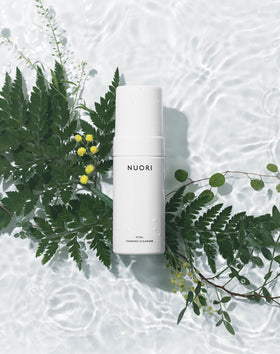The Truth About Beauty Product Shelf Life
For years, the skincare industry has spent billions extending the life of their products by months or even years. Has anyone asked why?
Today most skincare products are formulated to last at least 30 months, that is 2.5 years or longer. This is a result of EU regulation that was meant to increase consumer transparency but has in fact resulted in long shelf lives becoming the industry standard. In fact, a large share of research and development in cosmetics is still dedicated to artificially extending product stability.
We have been trained to believe that longer is better, expiration dates are bad, and that products should last forever. In reality, cosmetics are made using very similar ingredients and methods as medicine and food, which are both categories where expiry dates are mandated by law.
Long product shelf lives compromise efficacy

When NUORI Founder Jasmi Bonnén started looking into the shelf lives of cosmetic products, it surprised her to find numerous studies documenting that commonly used active ingredients, such as vitamins and peptides, are unstable in cosmetic formulations. In fact, many active ingredients start losing their beneficial properties in just a matter of few months due to molecular breakdown.
Take ascorbic acid (vitamin C), for example. Vitamin C is a hero skincare ingredient contributing to inhibition of melanin production, promotion of collagen biosynthesis, and prevention of free radical formation. But the molecule in its natural form is extremely unstable. It undergoes oxidation quickly and degrades itself irreversibly into a biologically inactive form.
The graph below shows that once vitamin C has been mixed into any kind of solution containing water, it immediately starts breaking down. After 120 days (4 months) there is 70% left of the original concentration, and after 8 months only 20% is left of what was added in the solution. So, you do not need to be a chemical engineer to understand that a cream that has been made for example 20 or 30 months ago, has very little left of its original efficacy.

Another downside of artificially extended beauty product shelf life is compromised product purity. To stay stable for several years, most skincare formulas contain synthetic preservatives and various other additives such as stabilizers, fillers, color, and fragrance enhancers. These additives do nothing good for the skin, and just take up space in the formulas leaving less room for skin caring and active ingredients.
Why is freshly blended skincare better?
Freshly blended skincare makes sense the same way fresh food does – it’s more nourishing and has fewer additives. Freshly blended skincare products have two distinct benefits:
/ The efficacy of any given formula is higher since active ingredients are not weakened by time-related breakdown.
/ The products can be kept truly pure and highly potent, as no synthetic preservatives, nor other additives, are needed to artificially prolong the stability and shelf life of the products.
When does my beauty product expire?
Very few cosmetic brands have expiry dates on their products due to the regulation that allows them to leave these out. Luckily, there is an increasing number of organic and natural beauty brands that now print expiry dates of their products.
If the product doesn't have an expiry date, you can check when your cosmetics were manufactured. On websites like www.checkfresh.com and www.checkcosmetic.net, you can check the manufacturing date by entering the brand name and batch number into their search engine.
The batch number is usually stamped at the bottom of the bottle or imprinted on the top of a tube.
Can You Use Skincare That Has Passed the Expiry Date?
The answer is “maybe”. Most professional skin care manufacturers carry out safety testing of their products. These tests are done to ensure that their formulas are preserved well enough to prevent bacteria and mold growth during the lifetime of the product.
The tests are calibrated to match the shelf life the products are intended to have. Therefore, once a cosmetic product has passed its expiry date (or has been open for too long), the risk of bacteria and mold growth increases. This can pose risks such as allergic reactions, skin irritation, eye infection, etc. In most cases, if a product has mold or bacteria growth, you will be able to recognize it from a slightly sour, “old dishrag” smell.
But remember, it’s not only about avoiding cosmetics that have turned bad. You also do not want to use old cosmetics because the active ingredients in them will in most cases no longer work as they should.
One product category where you should never use an expired product is sunscreen. Furthermore, sunscreens should only be used for one season. You should never use sunscreen from the previous summer, even if it has not yet expired. Exposure to air and high (or low) temperatures will all degrade the formula and reduce its protective function.
There Is More To Freshness Than Time
The better we protect cosmetic formulas from exposure to air, light, bacteria, and mold, the longer they stay fresh. Thus, the quality of the packaging is really important.
For example, choose products with airless pumps, and avoid jars at all cost (the combination of large openings and fingers inside the product is the worse!). Also, do not buy oils that come in transparent bottles, since sunlight causes oils to turn rancid. Finally, cosmetic products should never be left in temperatures above 25°C / 77°F over long periods of time.



